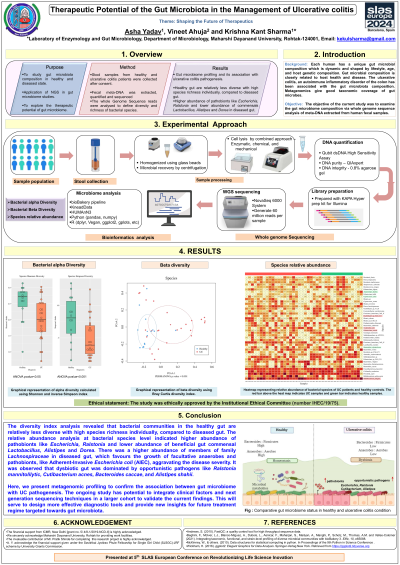Shaping the Future of Therapeutics
Poster Session A
(1060-A) Therapeutic Potential of the Gut Microbiota in the Management of ulcerative colitis
Tuesday, May 28, 2024
16:30 - 17:15 CEST
Location: Exhibit Hall


Asha Yadav
PH.D. Student
Laboratory of Enzymology and Gut Microbiology, Department of Microbiology, Maharshi Dayanand University, Rohtak, Haryana-124001, India.
Rohtak, Haryana, India
Poster Presenter(s)
Abstract: Human gut provides habitat to trillions of microbes that includes bacteria, archaea, fungi, protozoan, and viruses which are together defined as ‘gut microbiota’. Each human has a unique gut microbial composition which is dynamic and shaped by lifestyle, age, and host genetic composition. Gut microbial composition is closely related to host health and disease by regulating the host's metabolism as well as immune and neural response. The alteration in gut microbiome composition is increasingly used for diagnosis and treatment design for different metabolic and non-metabolic disorders. The ulcerative colitis, an autoimmune inflammatory disorder of the colon has been associated with the gut microbiota composition. Metagenomics give good taxonomic coverage of gut microbes. The objective of the current study was to examine the gut microbiome composition via whole genome sequence analysis of meta-DNA extracted from human fecal samples. The fecal samples from ulcerative colitis patients and healthy controls were collected after informed consent. The gut meta-DNA was extracted via modified THSTI protocol and whole genome sequencing was performed using Illumina Novaseq 6000 to generate 20 to 107 million (average ~47 million) reads. The diversity index (Shannon's index for alpha diversity and Bray- Curtis diversity index for beta diversity) analysis revealed that bacterial communities in the healthy gut are relatively less diverse with high species richness individually, compared to diseased gut. The reduction in the bacterial alpha diversity indicates less microbial richness in diseased condition; whereas, high species diversity in UC samples indicated by elevated beta diversity. The MetaPhlAn3 v3.0.13 was used for bacterial taxonomy analysis and identified 132 bacterial genera. The relative abundance analysis at bacterial species level indicated higher abundance of pathobionts like Escherichia, Ralstonia and lower abundance of beneficial gut commensal Lactobacillus, Alistipes and Dorea. There was a higher abundance of members of family Lachnospiraceae in diseased gut, which favours the growth of facultative anaerobes and pathobionts, like Adherent-Invasive Escherichia coli (AIEC), aggravating the disease severity. It was observed that dysbiotic gut was dominated by opportunistic pathogens like Ralstonia mannitolilytic, Cutibacterium acnes, Bacteroides caccae, and Alistipes shahii. Here, we present metagenomic profiling to confirm the association between gut microbiome with UC pathogenesis. The ongoing study has potential to integrate clinical factors and next generation sequencing techniques in a larger cohort to validate the current findings. This will serve to design more effective diagnostic tools and provide new insights for future treatment regime targeted towards gut microbiota.
